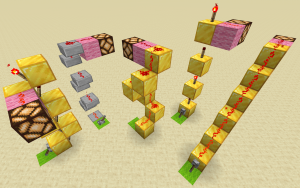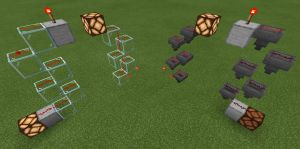Redstone circuits A structure built for players to control or activate other machines.
The circuit itself can be designed to respond to the player's manual activation, or to make it work automatically - or repeatedly output signals, or respond to changes caused by non players, such as biological movement, falling objects, plant growth, day and night replacement, etc. The types of machinery that can be controlled by Redstone in Minecraft almost cover the limits you can imagine, ranging from the simplest machinery (such as automatic doors and light switches) to elevators, automatic farms, small game platforms, and even computers built in games. Understanding how to build and use the Redstone circuit and its controllable mechanism can greatly increase the playable depth in Minecraft.
The topics of Redstone Circuit are very broad, and this entry is only an overview of Redstone Circuit. Click the main entry of each chapter to view the details.
Basic concepts
Before describing the basic Redstone circuit, you need to understand some basic concepts.
Rutile element
Red stone components are the basis of red stone circuits. Simple or complex red stone circuits can be constructed by purposeful use of red stone components.
Red stone elements can be roughly divided into three categories.
- Power supply (signal source)
- The power supply provides the signal source for the whole circuit or part of the circuit, and is usually considered as an output only component in circuit analysis
- Because the input source of such components is not Redstone circuit, but external intervention. For example, players Press Button; entity trigger Pressure plate (even if triggered due to active intervention of Redstone circuit); World light intensity changing with time and occlusion.
- yes Button 、 pull rod 、 Red stone block 、 Pressure plate 、 Solar detector Etc.
- Transmission element (transmitter, capacitor)
- The transmission element is responsible for Directly transmit and process the signal itself , it can accept input and output.
- yes Redstone 、 Redstone Repeater 、 Redstone Comparator 、 Redstone Torch Etc.
- stay Bedrock plate In addition to red stone powder, the transporters are called capacitor (The source code is like this), the capacitor source code belongs to a special class of "signal source" components.
- Mechanical components (consumers)
- Responsible for mechanical components Receive signals and react to intervene in the world (e.g. moving blocks, emitting light, launching missiles, etc.)
- Sometimes called consumer , because it only receives signals.
- yes piston 、 Redstone lamp 、 launcher Etc.
position
The range of "within two bars" measured by Manhattan distance A square occupies the space of a cube, which has 6 faces. That is to say, there are 6 squares that directly contact with the six sides of a square, which is called "the square adjacent to the square" Adjacent 。
The adjacency and adjacency of a square Manhattan Distance Is a square within two squares), commonly referred to as the Second-order adjacency 。 There are 19 blocks (including itself) adjacent to a block, and 25 blocks (including itself) adjacent to a second order block.
all around Generally, it refers to the four blocks that are in contact with the four sides of the block.
Red stone line, red stone torch and other squares need to be attached to other squares. Once the attached square is damaged, it will also fall. The blocks they attach are called their Attach 。
Some power supplies and transmission elements have their own point 。 Repeater 、 comparator The direction of is the square that the output end faces, Redstone Torch Is pointing to the square right above, Redstone The direction of is usually the same as that of its texture, but there are special cases.
Electrical and Mechanical
Both terms are generally used to refer to structures containing rutile elements, but they have certain differences:
- Circuit It refers to the structure of processing signal (generation, transmission, calculation).
- Mechanical Intervenes in the world (interacting with squares and entities).
Circuits that do not interfere with the world are called "static circuits", usually Not included Mechanics.
- Because its work is completely "static", it will not have any impact on the world.
On the contrary, a circuit that can interfere with the world is called a "dynamic circuit" and can be composed of any component.
All dynamic circuits must have machinery, so they can also be called mechanical circuits. However, the static circuit may have a mechanism (such as a red stone lamp used solely to display the calculation results). See below Basic categories Section.
Signals and pulses
Redstone circuit can generate signal ——"With/without signal" is called "1/0", "True/False" or "High/Low".
Upper edge/rising edge It refers to the instant when the red stone signal changes from nothing to something; Lower edge/falling edge It refers to the instant when the red stone signal changes from being to not being.
Phase Representing phase, it refers to the "same" and "opposite" in logic algebra (for example, "1" and "0" are opposite to each other).
When the signal appears One A relatively short "0-1-0" process, which is usually called pulse (or positive pulse. The process of "1-0-1" is called negative pulse). The duration of a pulse is called pulse length 。 See also below § Pulse circuit 。
Strictly speaking, the signal strength and length of a pulse are not limited, and there is no saying that a pulse is not called a pulse if its duration exceeds a certain value. For example, in the actual Redstone system, a pulse longer than 30 seconds can still be called a pulse. Also commonly used Long pulse/short pulse The statement of "" distinguishes pulses with different lengths.
signal intensity
signal intensity Usually an integer from 0 to 15. The red stone line can transmit signals to the adjacent red stone line, but the signal strength decreases by 1 for each grid. Therefore, the continuous red stone line can transmit the signal as far as 15 grids. For further transmission, you can use the Redstone Repeater Increase the signal strength to 15, or use Redstone Comparator Keep the signal strength unchanged.
The signal strength will be attenuated due to the direct conduction between the red stone lines, but it can also be Weighing pressure plate 、 Solar detector Or directly control the output of different signal strengths.
The red stone comparator can actually accept and output signals with strength less than 0 or greater than 15. If the number of successful times of the command box exceeds 15, or the contents in the container exceed the stacking limit, the ruby comparator will compare them as signals with strength less than 0 or greater than 15, or output them after making a difference.
stay Java version In the medium, signals with an intensity less than 0 or greater than 15 cannot be output to the red stone powder. Signals with an intensity less than 0 will be ignored directly, and signals with an intensity greater than 15 will become 15. Only the red stone comparator can be directly used to link into a chain for transmission.
stay Bedrock plate If the intensity is less than 0 or greater than 15, the signal can be output to the red stone powder, and the attenuation will also be correctly calculated, but only 15 grids can be transmitted at the farthest.
Charging
Some blocks can be charged and de charged. When the red stone signal acts on a square, if all mechanical elements adjacent to the square can be activated, the square is called Redstone conductor , this behavior is called Charging 。 The charged block is called Charging block 。 Most red stone conductors are opaque squares.
Strong charging and weak charging
Charging can be divided into strong charging and weak charging:
- Strong charging A square of can activate adjacent mechanical components and red stone components. Redstone conductor can be Power Supply And repeater and comparator. The properties of the strongly charged block are basically the same as that of the red stone block, but the red stone block is not a red stone conductor, and sure Change the shape, direction and direction of the red stone line Redstone Comparator Side input signal [Only Java version ] , while the strong charging block cannot.
- When red stone conductor Only by Red stone line charging, we call this block Weak charging 。 The difference between weak charging and strong charging is that the weak charging block cannot activate the adjacent red stone line.
The charging block cannot charge other blocks. Only the power supply and transmission components can charge one block.
Charging level
How many signal strength signals are used to charge a block, we will say how many blocks there are Charging level 。 The charging level of the strongly charged block can activate the adjacent Redstone To what signal strength. The charging level is completely independent of the strength and weakness of the charging.
activation
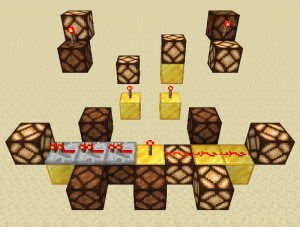
Activation of red stone lamp Mechanical components and red stone components can be used by power supply, charging block and transmission components in a specific way activation , trigger the reaction of mechanical components and red stone components (such as piston Push the block, open door , Redstone Torch Off, etc.).
Some mechanical elements will only react at the moment when they are just activated, and will not react again until they are deactivated and reactivated (such as pulse type command block Execute command, Thrower And launcher Throwing or launching objects, Note box Play a note). Other mechanical components remain active until deactivated( Redstone lamp Keep on, door Keep open, funnel Keep locked, piston Keep extending, etc.).
All mechanical elements can be activated by the following blocks( Exception: piston It is not normally activated by the block whose piston head faces):
- Adjacent Power Supply
- Exception: Redstone Torch The attached mechanical components are not activated, detector Blocks other than those they point to are not activated.
- Contiguous Charging block (Both strong charging and weak charging)
- Point to the mechanical element, output signal Redstone Comparator or Redstone Repeater
- Active Redstone , including the red stone powder attached to it. (Adjacent red stone powder that does not point to the mechanical element will not activate the mechanical element)
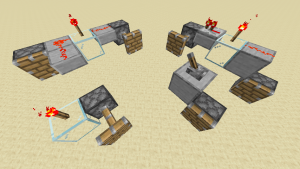
Semi connection Mode activation - at Java version The middle piston can also be activated above Space things activate. Note that the leftmost piston Not Activated by the semi connection, because the red stone powder does not directly point to the square above the piston, the piston cannot be activated Some mechanical elements can be activated in other ways (QC activation):
- stay Java version Medium, launcher 、 Thrower And piston It can be activated in the following way: that is, if the above four ways act on the square directly above the mechanical element (no matter what kind of square, even air), the mechanical element will also be activated. just as door The lower part of the. This situation can also be expressed as: the component can be activated by a square with 2 squares above or diagonally above. The right figure is an example of this kind of activation mode. This method is called Semi connection 。
- door Occupy 2 spaces, activate any half door The other half will also be activated.
Charging and activation
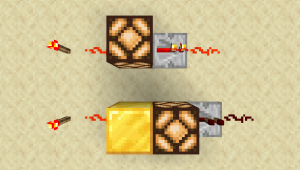
Charging and activation - the red stone lamp above is both "activated" (so the red stone lamp is lit) and "charged" (so the adjacent repeater is activated), but the red stone lamp below is only "activated", not "charged" For mechanical elements belonging to red stone conductors (including command block 、 Thrower 、 launcher 、 Note box And Redstone lamp And so on), can be charged or activated. Therefore, it is very important to distinguish whether they are activated or charged:
- If it can activate adjacent Redstone components and mechanical components, it will be Charging Has.
- If it makes a certain response, it will be activation Has.
As long as the mechanical element is charged, it will also be activated, but if it is activated, it will not be charged (such as activated by adjacent charging blocks).
Mechanical elements that are not red stone conductors( door 、 Fence gate 、 piston 、 funnel 、 rail 、 Flap door And so on) can be activated and react, but cannot be charged because it does not have the property of red stone conductor.
Block update (narrow sense)
When the state of a block changes, the change will cause Block Update 。
stay Java version In, the operation of the Redstone circuit depends on the block update mechanism. A single block update will make other red stone elements around receive the prompt of "change nearby" to detect whether they should change. If there is a change, a square update will be issued around. Update causes change, change creates update, which will be a chain reaction, and the circuit may not reach a completely stable state.
stay Java version In, charging is not an internal mechanism of the game, so no matter whether it is charged or de charged, block updates cannot be generated. When a component changes, it updates blocks within a sufficient range of surroundings to make the circuit work properly (for example, a pressure plate updates its adjacency and its attached adjacency).
In addition to updating the blocks, the Redstone Comparator can also be updated through the containers in the two grids behind it (including the detection rails with transport tramcars) and changes in some other blocks (such as changes in items in the item list); The detector can also detect some block changes and update them.
The following is Java version The normal box update range in:
The following red stone elements produce a square update of the second order adjacent range:
Adjacency of pull rod and its attachment (including its attachment) The renewal range of the block generated by the following red stone elements is its adjacency and the adjacency of attachment (or direction):
Pointing and Adjacent Points The update range of the following red stone elements is pointing and pointing adjacent (except for the position of the element itself):
The renewal range of blocks generated by the following red stone elements is their adjacency, the adjacency of the blocks above them, and the adjacency of the blocks below them:
The following red stone elements produce only adjacent updates to the block:
When the status of the following blocks changes can't Trigger block update:
Redstone system
- brief introduction
- Bedrock plate The directed graph is used to manage the Redstone circuit, called Redstone system 。 The drawings of the Redstone system are stored in the adjacency table. The operation of Redstone Circuit mainly depends on the Redstone system and is also affected by Block Update Impact.
- The Redstone system will store all Redstone components, record the connection mode and attenuation between components, and cache the information of some surrounding physical blocks. Every two Game engraving The red stone system will update the signal once, calculate and set the red stone signal of each red stone element.
- Bedrock plate Redstone Compared with the Java version of Redstone Powder, the performance overhead of is overwhelming. Rutile powder is equivalent to "nonexistence" when the circuit connection does not change, which saves a lot of calculation. However, due to the defects of the directed graph search algorithm of the bedrock version, there will be relatively large performance overhead when the circuit connection changes (but the performance overhead of re searching the directed graph can also be minimized through special design).
- Some details
- Redstone components can be roughly divided into four categories: signal source, capacitor, consumer and transmitter.
- signal source
- Capacitor (a special signal source)
- Transporter
- The transmitter is only responsible for transmission (constructing directed graph), and its calculation can be ignored after the construction of the adjacency table is completed (without affecting the normal calculation of the signal).
- The sender only Redstone 。
- consumer
- expand
- Directed graph data is not stored in the archive data (search again every time you enter the archive or load the block. In order to save space for the archive), and only the components in the block loaded by the player are added. So even if a large number of components are placed in a block, as long as the block in which they are located is not loaded, these components will not be re searched and entered into the adjacency list, and the game speed will not be slowed down.
- Some circuits will be affected by microsequence disturbance, such as special state Torches High frequency can be affected by image re search; face to face detector High frequency will be affected by the block.
- Even though it is counter intuitive, some elements can not change the direction of red stone powder (such as Target 、 piston 、 clock )。 They can only add themselves or connect to themselves (such as input repeaters, comparators, torches of directly connected targets; red stone powder placed on the piston) to the adjacency list, and cannot interfere with the search direction of the graph. This is because the priority of the line connection is higher than that of the charging connection (the line connection is processed first, and then the charging connection is processed after the line connection is processed. If the line connection and the charging connection point to the same element, Result of directly selecting line connection , regardless of the result of the charging connection (even if the attenuation of the charging connection is low).
Red stone carving
Redstone tick abbreviation moment or rt , that is, 2 game moments (if there is no stuck, it is equal to 0.1 second).
stay Java version Since most of the red stone components need an integer multiple of 2 to change the state of the game engraving, the red stone engraving was once defined as the minimum time unit for Minecraft to update the state of the red stone components, and was widely used by players in the red stone circuit. With the further understanding of the game mechanism Game engraving (Game tick is called "gt" for short) as the minimum time unit.
stay Bedrock plate In, the signal of the Redstone element is usually calculated once every 1 game. Therefore, red stone carving can be used as a time unit, equal to 2 game carving; You can also use the terms "red stone carving" and "non red stone carving" to refer to a game carving to distinguish whether the game carving updates the red stone signal.
Circuit volume
Generally, the format of length × width × height (circumscribed cuboid of circuit) is used to describe the volume of the circuit used to process signals, including the blocks used for attachment at the bottom layer, and excluding the blocks or structures of input signals or output signals. The unit is block (b for short).
Another way to describe the circuit volume is to ignore the block supporting the circuit at the lowest layer (for example, the block below the red stone powder at the lowest layer). However, this method cannot distinguish Planar circuit And One grid high circuit 。
Circuit characteristics
According to different design objectives, some common features should be considered:
- 1 grid high circuit
One grid high circuit has only one grid, which means that this circuit cannot have components that need to be attached to the lower block (for example Redstone line 、 Redstone Repeater )。
- 1 grid width circuit
One grid wide circuit refers to at least one circuit with a horizontal dimension of 1. Also called monolithic circuit.
- Planar circuit
It refers to a circuit that can be built directly on the ground plane without the need for stacked elements (excluding the ground plane used to support the red stone elements). Planar circuits are usually good for beginners to understand and learn.
- Traceless circuit
It refers to the circuit that can be completely hidden in a wall, under the floor, or above the ceiling (i.e. traceless circuit). The feature is that circuit components are not exposed when opening/closing. This kind of design is often used for piston doors.
- Non delay circuit
Refers to a zero delay circuit that changes the output immediately after receiving the input signal (in fact, there is still delay, but it is less than 1gt).
- Silent circuit
A circuit that does not produce sound. This circuit will not have piston 、 launcher 、 Thrower And other components that will make a noise. These circuits are suitable for trap , quiet environment and the construction of circuits that need noise reduction.
- Stackable circuit
It refers to the circuit that the same circuit can be directly stacked next to or above another, and each unit can be controlled by a total input after stacking.
- Parallelable circuit
It refers to the circuit that the same circuit can be directly stacked next to or above another circuit, and each circuit will not interfere with each other after stacking.
- Other possible design objectives
This includes reducing the delay of sub circuits, reducing the consumption of expensive components (such as detectors), and minimizing the size.
Basic categories
According to the principle, function and realization goal of the circuit, players in the Chinese area divide it into three categories and other categories.
digital circuit
Digital circuit, referred to as digital circuit for short, refers to the realization of logic operation through the red stone elements and logic mechanism (or, or, or not) given by the game. Digital circuits generally implement various operations based on binary operation rules and logic operations, thus realizing various complex calculators and computers. Digital circuit is a subject in reality. Without knowledge and thinking foundation, digital circuit is more complex and profound for ordinary players.
Digital electricity is divided into three schools: traditional digital electricity, modern digital electricity and non delay digital electricity.
- Traditional digital electricity
- Traditional digital electricity only uses Static circuit To complete the logic of the entire circuit, only used at the circuit output Dynamic circuit 。
- For example, a four arithmetic unit that uses a piston screen to display results can only use dynamic circuits at the piston screen by definition.
- Modern digital electricity
- Modern digital electricity still requires that the main logic of the circuit use static circuit, but it is allowed Reasonably Use dynamic circuits (such as wall electric or photoelectric) to improve circuit performance.
- For example, a 10Hz dual channel read-write 16384 byte RAM with 16 blocks and an access time of 1-4 seconds using optoelectronic technology. With such speed and bandwidth on the premise of storing array density up to 2 blocks/bit data, the performance of this circuit cannot be matched by traditional digital power.
- Data without delay
- Because no matter in traditional digital electronics or modern digital electronics, complete delay free digital electronics are excluded, so delay free digital electronics are independent. Delay free digital electricity usually pursues special realization under the premise of no delay: smaller volume or lower stuck; Or to verify the feasibility of some extremely complex mathematical logic in Minecraft (if no delay circuit is used, it means that the time cost is too high).
- For example: no delay four way calculator, no delay Edge logic Computing system, 10Hz central processor, etc.
Compared with analog power, digital power has faster speed and larger volume.
Analog circuit
Analog circuits, referred to as analog circuits, are used to process and calculate the signal strength by comparison or subtraction mode of comparators.
“ simulation ”It means "continuous change". However, Minecraft's Redstone signal is actually discrete in strength and time (for example, there is no 11.45 strength signal, and there is no signal whose length cannot be measured). Such signals and related processing circuit logic are called Multilevel logic (Belongs to digital circuit). The word "simulation" is used here to distinguish Signal Yes No and signal intensity Transmission and calculation of. In real life, the difference between digital electronic technology (generally two-level logic, only high or low level) and analog electronic technology (focusing on continuously changing potential) is the most similar. Therefore, the terms "analog" and "digital" are widely used, but please remember that they are different from reality and should not be confused.
Redstone analog circuit is mainly divided into weak signal analog circuit (weak mode) and strong signal analog circuit (strong mode). Weak modulus is processed and calculated based on 0~15 signal strength, and the operation rules are generally based on hexadecimal or decimal. Strong mode makes use of the characteristic that the comparator allows the signal strength to exceed 15, and uses the analog signal of 0~2147483647 signal strength for operation and processing. Some analog circuits will also use the red stone signal less than 0 for calculation.
Compared with digital electronics, analog electronics has a slightly slower speed and smaller volume.
Mechanical circuit
Mechanical circuit, referred to as mechatronics, is a circuit that uses various game characteristics of pistons, viscous pistons, launchers, etc. to achieve goals.
According to the design objectives, it can be divided into high-speed electromechanical and high-voltage electromechanical. High speed mechatronics gives priority to speed, followed by volume reduction (such as 2 × 2 traceless glass doors that open in 0.15 s). High voltage mechatronics gives priority to the pursuit of reducing the volume, followed by the pursuit of speed, so the timing is usually complex (such as the 6 × 6 piston door with a volume of only 760 square meters, opening and closing the door for a total of 75 minutes) [1] 。
Aircraft technology
Aircraft technology, also known as aviation machinery, mucus block technology (Green Meng), piston worm, etc. Aircraft technology is derived from mechanics and electricity. It uses pistons and slime blocks/honey blocks to realize unidirectional or multi-directional navigation machinery, and can also be used for other types of mobile circuits, such as world devourers, mobile vector guns, mobile 3 × 3 gates, etc.
Survival utility circuit
The survival practical circuit is called electricity generation for short. Electricity generation has a wide range of definitions. It usually combines the advantages of digital electricity, analog electricity and mechanical electricity. Its main characteristics are Survival mode Service, so it pursues less consumables, low stuck, strong stability, etc.
TNT Cannon
TNT artillery is based on the research and modeling of TNT entities, and the design of gun bore.
Vector gun
The vector gun uses orthogonal decomposition to control two mutually perpendicular forces acting on the same point of the warhead by controlling the number of TNT of two mutually perpendicular bore, so as to achieve accurate strike effect.
Basic circuit
Although the methods of circuit construction are endless, the circuit construction style for specific functions is relatively fixed. The following chapters classify some circuits, and each chapter has an independent main entry to describe the specific circuit design scheme.
Some circuits may only complete the simplest control function, but only a few such simple circuits need to be combined to form a complex large-scale circuit that can meet the goal.
Pulse circuit
Some circuits need specific pulses to work, while others use pulses to convey specific information. In such an environment, pulse circuits come in handy.
Circuits that are stable in one state and unstable in the other are usually called Monostable circuit 。 Most pulse circuits belong to monostable circuits because their active state (unstable state) can only return to the stable state for a short time.
- Pulse generator: generates pulses of specific length.
- Pulse limiter: it can shorten the long pulse. It is also called pulse shortening device.
- Pulse stabilizer: it can lengthen too short pulse. Also called pulse extender.
- Pulse delay: it can provide delay for the pulse (partial pulse delay will change the pulse length).
- Edge sensor: output pulse when the signal changes: from 0 to 1 ("rising edge" sensor) or from 1 to 0 ("falling edge" sensor), or both ("double edge" sensor).
- Pulse length identifier: It can output signals when the input pulse length is within a certain range.
Clock circuit
The clock circuit is a pulse generator that continuously and repeatedly provides pulses of a specific length. Some clock circuits work automatically, while others work under control.
The length of time from the beginning of one pulse to the beginning of the next pulse is called clock circuit cycle 。 In a cycle, the ratio of the length of a pulse to the total length of the cycle is called Duty cycle , the higher the duty cycle, the better.
A simple clock circuit has only two equal length states (duty cycle is 50%). For example, 1rt is active and 1rt is inactive (2rt cycle clock).
- ring Clock
use Repeater 、 comparator even to the extent that Redstone Torch To form a chain, the head and tail of the chain are connected to form a ring, which is used as a clock circuit. The cycle of the ring is determined by the number of elements that make up the ring. There are two designs: rotating ring (simply rotating the signal in the ring, which is easy to understand) and antiphase ring (reversing the signal every cycle based on the rotating ring. The cycle length is twice that of the rotating ring under the same number of elements. Usually comparator 、 Redstone Torch To obtain the phase inversion function).
- funnel Clock
funnel Clock Pass funnel The chain circulates goods through Redstone Comparator Detect output. The funnel clock has very small volume and consumables.
- piston Clock
utilize piston Or viscosity piston Push and pull on the block to delay building the clock. The consumption of piston clock is high and the duty cycle is usually difficult to control (for example, it is very difficult to build a piston clock with a duty cycle of 50%).
- Detector clock
Place two detectors whose observation ends are opposite to each other, and then place a red stone element behind them.
- Other clock design
The clock circuit can also be based on jukebox 、 Solar detector 、 Tramcar 、 ship The natural disappearance of falling objects water Flow, etc.
Transmission circuit
Using a variety of transmission components and game mechanisms, we can build transmission circuits that meet various needs (such as high density, high speed, high throughput, low stuck, etc.).
The purpose of signal repeater is to "relay" the signal, that is, to make the signal transmit farther. The simplest repeater is Redstone Repeater , which changes the signal strength to 15 for further transmission. The following circuits can also be used:
- Instantaneous repeater : Relay signal without introducing delay.
- Two-way repeater : It has two ports with input and output (it can relay signals from two directions).
"Diode" refers to a circuit that only allows one-way transmission of signals, and is usually used to prevent wrong triggering, line crosstalk or delay disorder caused by reverse transmission of signals on the line. Common non delay diodes are steps, glass or funnel.
Some components are unidirectional because their output terminals do not accept input signals (such as redstone repeaters, redstone comparators, redstone torches, etc.).
Longitudinal transmission circuit
Although horizontal transmission is simple and direct, sometimes we need vertical transmission to meet the demand. Here are some simple longitudinal transmission circuits:

Down vertical transmission - Redstone stairs
The simplest longitudinal transmission is laid on the diagonal block Redstone line , or use a 2 × 2 spiral structure, etc. Red stone staircase supports up and down signal transmission without delay, but it occupies a large area, and relay signal is required when the signal is transmitted to more than 15 grids.
- Redstone ladder
because Fluorspar , Invert stairs And steps The signal can be transmitted longitudinally on the 2 × 1 "ladder", but only Transfer up , which is also equivalent to a longitudinal diode. Redstone ladders occupy a small area and have no delay, but every 15 need to be relayed. stay Bedrock plate In, 1 × 2 ladder type longitudinal direction can be constructed through glass or piston two-way Transmission. The Red Stone Ladder is extremely fast but occupies a slightly higher area.
- Torch tower
Redstone Torch The square above it can be charged and the adjacent red stone elements can be activated. With this feature, longitudinal transmission is possible (different designs for up and down). Torch tower consumes less materials and occupies less land, but the delay is high.
- detector wireway
utilize detector Other detectors can be detected to form a detector chain, and a transmission line in any direction can be constructed. The detector leads have very high latency but very small footprint.
However, you can use the Can be activated and detected Of the box (e.g clock 、 launcher 、 Thrower 、 door 、 Flap door 、 Fence gate 、 funnel 、 Note box 、 piston 、 Powered Rail 、 Activator Rail 、 Redstone lamp And so on) to increase the detector spacing without changing the delay. On this basis, you can also add red stone powder and red stone conductor to increase the detector spacing again. Then, the number of detectors used by the detector chain is compressed (and the speed is increased, and in some cases, the jam can be reduced). The block that can be activated and detected will also make the detector wire have different delay and characteristics.
Analog electric transmission circuit
- General transmission scheme
If required Non destructive Transmit the signal (i.e. retain the original signal strength). The general transmission scheme is naturally the first choice.
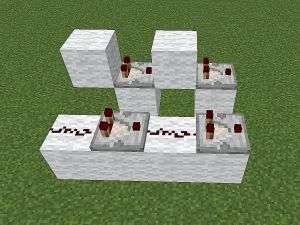
The most basic module electric wire, the highest N Rt transmission 2N Grid. It's usually a little slow 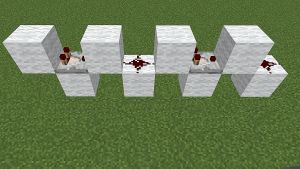
Faster mold electric wire that uses strong and weak charging to speed up, the highest N Rt transmission 4N grid Directly use the comparator to charge the ruby conductor or ruby line, and then activate the next comparator to charge the next ruby conductor or ruby line (in this cycle) until it reaches the target position. You can also increase the transmission distance by using the strength of the block charging.
If it is necessary to transmit the mode electrical signal up and down, the characteristics of the rutile powder that can charge the lower rutile conductor can be used to make the signal lossless downward transmission (and allow 2-high stacking); Uploading lines need to be completed by charging the red stone conductor at the strong charging output of the comparator and charging the red stone powder above (unable to stack 2 high, and will string lines)
The general transmission scheme has high flexibility, medium consumption, but extremely slow speed.
- Repeater transmission scheme
If required long distance or fast It may be a good scheme to transmit analog electrical signals to binary signals and then transmit them, but this will bring additional conversion delay and converter volume (and greatly increase the consumption). Can you quickly direct What about transmission mode electrical signal? The answer may be unbelievably simple!
- By using the attenuation characteristics of Minecraft Redstone itself and matching with Redstone repeaters, we can obtain the fastest mode electric wire.
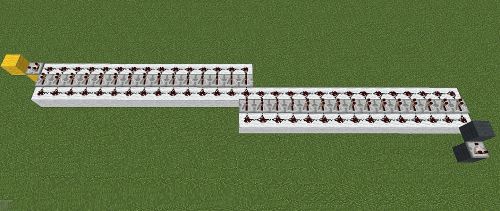
- The world's fastest modular electric wire, N Rt transportable 14N+1 Grid. Grey is input, yellow is output.
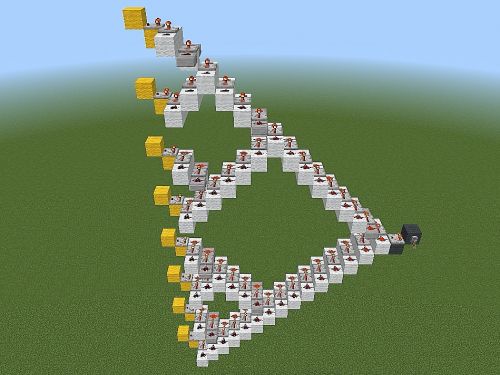
- The fast analog electrical wire arranged in the form of binary tree can send the input to all 8 outputs with only 1rt. Grey is input, yellow is output
This kind of modular electric wire Extremely powerful ! The maximum throughput is up to 10Hz and the signal can be transmitted up and down! You can also arrange such mold wires like a red stone ladder!
This design can also ignore part of the "line loss" when the strength range is less than 0~15 to reduce the number of components used, so as to reduce the sticking and consumables without changing the speed.
The repeater transmission scheme is a little less flexible and a little more consumable, but it is extremely fast.
Miscellaneous transmission circuit
- Solar detector transmission
This transmission technology is also called photoelectricity 。 The principle is that when the sunlight is unobstructed in the sunny day, it is always 15 levels of brightness, and a daytime only Ignore vertical distance 、 No delay 、 vertical The transmission path (difficult in other directions and short in distance) is called "optical path". The output signal of the sun detector in the light path can be controlled only by using the piston push-pull block or emitter (group) to control the fluid to control the occlusion of the light path. Sunshine detector blocking controller Also known as Light control 。 Photoelectricity is characterized by continuous signal transmission.
stay Java version The sun detector is updated every 1s (up to 1Hz signal transmission can be realized); stay Bedrock plate The sun detector will be updated every 1rt (up to 10Hz signal transmission can be achieved, and 4 viscosities are required piston Or 3 launcher 10Hz dedicated optical control).
- entity transmission
It mainly includes ejection, falling Bubble column The lifting and moving entity to the sensing position can be reset by itself (the receiving and sending of two single items are inversely overlapped), which can realize the transmission through the wall. Generally, the farther the distance is, the faster the entity speed is. The delay is usually difficult to calculate, so you need to have some understanding of the game mechanism. The physical transmission is usually slightly higher, but it can greatly expand the wiring possibility.
- wall transmission
The model mechanism and detector of Minecraft wall can be used to detect the update of wall model. You can use the wall to build a vertical downlink line and use Flap door Control. This technology is called wall electricity. It is characterized by the edge of transmission signal.
Wall electricity Java version Is downloaded without delay in Bedrock plate In the middle, 1gt is transmitted down to one grid, which is a detector.
- leaf transmission [Only Java version ]
utilize detector Can detect leaf connection or disconnection Log , you can use leaves to build a line of any form and use piston Or viscous piston and log control. This technology is also called tree power. It is characterized by the edge of transmission signal.
The maximum transmission distance of tree electricity is 7 leaves.
- Bubble column transmission
utilize detector The change of bubble column can be detected by building a completely vertical water column and controlling it through a piston or viscous piston at the bottom Soul Sand or Magmatic block Control the bubble column to upload and transmit. This technology is also called bubble electricity. It is characterized by the edge of transmission signal.
Bubble electricity in Java version Upload without delay in Bedrock plate In the middle, it is 1gt upload 1 grid.
logical circuit
By judging whether the input signal meets the logic, a specific output will be generated if it meets the logic. Such circuits are familiar to people Logic gate 。
Logic gate output
Display the output (red) of the logic gate corresponding to the combination of each input A and B (green)
| A |
open |
open |
shut |
shut |
Corresponding language expression |
| B |
open |
shut |
open |
shut |
| Not A
|
shut |
shut |
open |
open |
Is A 0? |
| A or B
|
open |
open |
open |
shut |
Is there an input of 1? |
| A or Not B
|
shut |
shut |
shut |
open |
Are all inputs 0? |
| A and B
|
open |
shut |
shut |
shut |
Is the input all 1? |
| A and non B
|
shut |
open |
open |
open |
Is there any input of 0? |
| A XOR B
|
shut |
open |
open |
shut |
Are the two inputs different? |
| A Same as or B
|
open |
shut |
shut |
open |
Are the two inputs the same? |
| A contains B
|
open |
shut |
open |
open |
If A is 1, is B also 1? |
- Non gate (i.e. "inverter"): the input is opposite to the output.
- OR Gate : When any input is 1, the output is 1.
- OR NOT gate : When any input is 1, the output is 0.
- And door : When all inputs are 1, the output is 1
- NAND gate : When all inputs are 1, the output is 0.
- Exclusive OR gate : When the input is different, the output is 1.
- xnor : When the input is the same, the output is 1.
- Entailment gate : The output is 0 only when the first input is 1 and the second input is 0.
The NOT gate is a unary logic (with a single input).
Other logic gates are binary logic (with two inputs).
The OR gate whose output is negated is the OR gate. The negative output of the AND gate is the NAND gate.
The exclusive OR gate and the same OR gate can be converted by adding a non gate to any input/output (the total number must be an odd number to be converted, and the logic of the total number of even numbers remains unchanged).
Memory circuit
Unlike the logic circuit which only reflects the input signal, the output of the memory circuit is not only related to the input, but also to the "past input". This can complete the "memory" of the past state of the circuit. In real life electronics, Latch It refers to the circuit that reacts to a certain state of the input signal; Flip flop A circuit that responds to changes in input signals. There are many memory circuits to choose from. Here are some common ones.
- RS latch
The RS latch is used for status registration. With input Set (short for S, change state) and input Reset (short for R, reset state), output O and output O '(the states of O and O' are always opposite). When input S is 1, output O is 1 and O 'is 0; When R is 1: O is 0, O 'is 1.
The logic structure of RS latch is two NOR gates. In Minecraft, two torches can be used to realize RS latch (it is the oldest and most common memory circuit in Minecraft).
- t flip-flop
T trigger is used for signal switching (similar to pull rod). It has input (abbreviated as I) and output (abbreviated as O). When I Flip when conditions are met (0? 1? Rising edge? Falling edge?) O The state of (1 becomes 0, 0 becomes 1).
- D trigger
D trigger is used for storage. It has regular input (I for short), clock input (CLK for short) and output (O for short). When CLK When is 1 O Will be set to I Status of, when CLK When is 0 O The original state will be maintained.
D trigger can be regarded as an upgraded version of RS latch (and D trigger can be realized by RS latch), Repeater Actually, it is also a D trigger, but the CLK is negated.
- jk flip-flop
It is similar to RS latch, but RS latch does not support R end and S end being 1 at the same time. When JK trigger is 1 at J end and K end at the same time, it will flip the output signal (1 becomes 0, 0 becomes 1). In reality, it is used to implement T triggers, but it is not very useful in Minecraft.
Miscellaneous circuit
- Random signal generator
Random signal generator can generate unpredictable signals randomly. Some random signal generators make use of the random characteristics of Minecraft (such as cactus Growth, launcher And Thrower Selection of actuating groove), priority of piston pushing each other [Only Bedrock plate ] ; Others are realized by implementing mathematical pseudo-random algorithm.
- Oscilloscope
It is divided into digital oscilloscope and analog oscilloscope: digital oscilloscope is a repeater chain composed of several repeaters connected in turn, according to which the pulse length can be measured visually through the lighted repeater. Or direct observation Digital serial data string ; The analog oscilloscope is connected with several comparators in turn and arranged among each comparator Intensity display It can directly measure the pulse energy intensity. Or direct observation Analog serial data string 。
- Counter
Counter It is a device used to record the number of times the input meets the conditions. The binary counter (or digital electric counter) is usually composed of cascade Therefore, the counting conditions are related to the satisfaction conditions of the selected T flip-flop. Modular counters (ranging from 3 to 16) are usually composed of modular registers and carry judgment.
- Block Update Detector
Block Update Detector( B lock U pdate D Detector, abbreviated as BUD) is a circuit that updates blocks (such as stones being excavated, water turning into ice, pumpkins growing out, etc.) as input, and executes a specific response after detecting the input. The monostable BUD reaction is an output pulse, while the T-BUD (bistable BUD) reaction is a switching output state (it can also be realized by using the monostable BUD with a T trigger). detector It is also considered as a kind of monostable BUD. stay Java version In, the BUD usually depends on the piston. Tutorial: square update sensor More information.
- Selector and distributor
Selectors (also called multiplexers, data selectors, hubs) have Multiple input , One output as well as Select input C. The input of C determines which input to output.
Distributors (also called multiplexers, data distributors and splitters) have One input , Multiple input as well as Select input C. The input of C determines which output the input is connected to.
With selector and allocator, you can build a data bus , Any input can be connected to any output (and save a lot of dedicated transmission lines), The number of connections allowed at the same time depends on the number of design channels 。
Build circuit
plan
The first step in building a Redstone circuit is to determine what the circuit can do.
- Where should the entire circuit be controlled? How to control?
- Is the circuit controlled by the player, biological movement control or other control methods?
- What function can the circuit achieve?
- Lighting, pushing blocks/creatures, identifying objects or others?
- How is the signal transmitted from the control end to the machine?
- Do you need to combine signals from multiple sources?
build
It is a good habit to use specific combinations of blocks when building circuits, so as to distinguish the range of circuits. Common choices are quartz 、 Iron block , dyed square (such as wool 、 concrete 、 Ceramic tile Different blocks are convenient to distinguish different parts of the circuit.
Be careful when building circuits near liquids. Many circuit components will be damaged by liquid.
Be careful when constructing circuits containing TNT, such as traps or cannons. The circuit under construction may ignite TNT accidentally, so please control the time of placing TNT. For example, if you place the Redstone Torch on the charged square, it will not know that it should be turned off and can temporarily provide signals for the circuit until the next game moment. Placing TNT after the rest of the circuit is completed will help avoid machine damage caused by such problems. This also applies to any other features of the circuit that may be accidentally activated by this action (for example, activating the transmitter before the circuit is ready or filling the contents of the transmitter after the circuit is ready).
solve the problem
When there is a problem with the circuit, check it carefully and try to find the source of the problem.
- Is the signal coming from a weak charging block? Maybe Redstone Repeater Make it strong charged, or use red stone repeater to lead out signals.
- Does the red stone signal pass through a red stone insulator? Replace it with a red stone conductor, or take a detour.
- Did you unintentionally build a short circuit circuit that burned the Redstone torch that should have been activated? Correct the short circuit circuit and update the status of the Redstone torch.
- Is the part of the circuit that should not be activated activated incorrectly? Maybe the lines in different parts are connected by accident.
- Is the piston, launcher or thrower activated in the wrong way?
optimization
After the circuit works normally, consider whether it can improve the performance of the circuit.
- Can the circuit respond faster (with lower latency)?
- Reduce unnecessary components in signal transmission, such as repeaters and Redstone torches.
- Optimize circuit logic and shorten the "input" - "result" path.
- Can you make the circuit smaller?
- Can I use fewer squares?
- Can transmission path routing be optimized?
- Optimize the circuit logic to minimize the invalid volume.
- Can it make the circuit more stable?
- Can the circuit still work normally when working at high frequency?
- Can the circuit still work normally under frequent active/inactive alternation?
- Will the features of the new version of Minecraft help improve the efficiency of the circuit?
- Can the circuit noise be reduced?
- Can you use as few sound making blocks as possible?
- Can you reduce any stuck?
- Many Redstone components often change their states, resulting in a large number of light calculations, sound, and particle rendering, which leads to computational or rendering stuttering. Can you try to suppress these useless calculations?
- Is it possible to lock the funnel and control it to only try to suck and output when it needs to work? Can a compost bucket be placed on the funnel to minimize funnel sticking?
See




